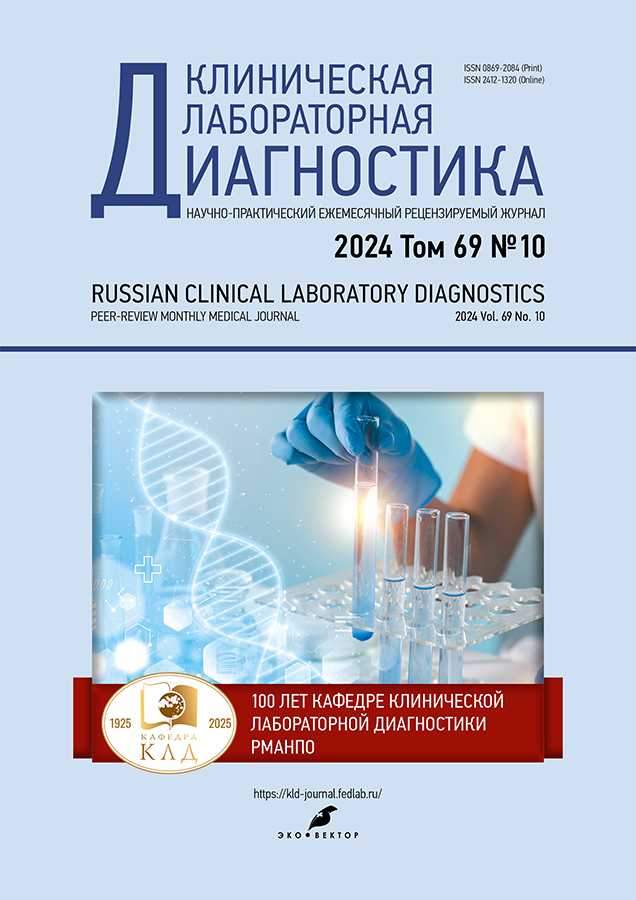Problems of the implemenation of the unified laboratory information system of the city
- 作者: Mudrov V.P.1,2, Efimushkina O.A.3
-
隶属关系:
- Russian Medical Academy of Continuous Professional Education
- Moscow City Hospital No. 52
- Moscow City Hospital No.52
- 期: 卷 69, 编号 10 (2024)
- 页面: 306-313
- 栏目: Original Study Articles
- ##submission.datePublished##: 28.02.2025
- URL: https://kld-journal.fedlab.ru/0869-2084/article/view/653989
- DOI: https://doi.org/10.17816/cld653989
- ID: 653989
如何引用文章
详细
Background: In the development of clinical laboratory diagnostics around the world, the direction has been taken towards the centralization of laboratory research. A centralized laboratory information system based on cloud technology is a single system with a single database that ensures data synchronization between various clinical and diagnostic laboratories and the ability to prepare any type of consolidated financial statements. The choice of a single Laboratory Information System (LIS) platform for citywide use with the possibility of replication to all laboratories of the city, taking into account cost-effectiveness, adaptability, efficiency, ease of integration with other IT medical products of the city among the available laboratory information systems led to the decision to create a new unified laboratory information system for all laboratories of the city of Moscow.
Aim: Summarizing the experience of implementing a unified regional (urban) laboratory information system in a multidisciplinary medical organization.
Material and methods: The Moscow Department of Health provided the LIS EFIR system based on a cloud architecture with unified reference books. To coordinate actions during the implementation of the project, a working group was created consisting of responsible employees of the clinical diagnostic laboratory No. 1 and specialists of the Moscow Department for the implementation of LIS. Taking into account the risks during the transition from one LIS to another and the preventive measures taken minimized the possible risks during the switch.
Results: Taking into account the risks during the transition from one LIS to another and the preventive measures taken minimized the possible risks during the switch. The transition to another LIS without stopping the laboratory process, without reducing the volume of testing and maintaining the timing of the results, led to an increase in the workload of the laboratory staff. This led to an increase in the number of inconsistencies, but the situation was stabilized and not only returned to the original percentage of defects, which was 2–2.5%, but also reduced it to 1%.
Conclusion: As a result of the implementation of the LIS, Moscow City Hospital No. 52 received a modern, reliable tool for managing the work of the entire laboratory complex. The implementation process went better than expected, which was confirmed by all project participants. The LIS EFIR implementation project has been successfully implemented, and this experience can be used in other medical organizations in the city.
全文:
作者简介
Valeriy Mudrov
Russian Medical Academy of Continuous Professional Education; Moscow City Hospital No. 52
编辑信件的主要联系方式.
Email: vpmudrov@yandex.ru
ORCID iD: 0000-0003-1129-8335
SPIN 代码: 4934-3745
MD, Dr. Sci. (Medicine)
俄罗斯联邦, Moscow; MoscowOksana Efimushkina
Moscow City Hospital No.52
Email: kdl9312@gmail.com
ORCID iD: 0000-0002-9215-2719
MD, Cand. Sci. (Medicine)
俄罗斯联邦, Moscow参考
- Latypova MF, Shamanskij MB, Makarov VV, et al. Centralized laboratory information systems: the expediency and attractiveness of a single nomenclature of clinical laboratory research. Spravochnik zavedujushhego KDL. 2016(12):15–32. (In Russ.) EDN: XEKFPR
- Gascón F, Herrera I, Vázquez C, et al. Electronic health record: Design and implementation of a lab test request module. International Journal of Medical Informatics. 2013;82(6):514–521. doi: 10.1016/j.ijmedinf.2013.03.006
- Ilyin AV. Implementation experience of laboratory information management system in a single information complex. Laboratory Service. 2016;5(4):46–49. doi: 10.17116/labs20165446-49
- Panfjorova IS, Makarova IV, Kurbatov AV. Laboratory information system. A reasonable choice and reasonable requirements. Spravochnik zavedujushhego KDL. 2018;9:57–65. (In Russ.) EDN: YSXCZF
- Latypova MF, Cibin AN, Ivanushkina OI, et al. Current legal regulations for information systems in laboratory medicine. Spravochnik zavedujushhego KDL. 2017;10:67–79. (In Russ.) EDN: ZSWNND
- Andrjukov BG, Andrjukov IB, Gel’man EA, et al. Experience creation and implementation of laboratory information systems in the practice clinical diagnostic laboratories the multidisciplinary departmental medical centers. Marine Medicine. 2017;3(1):34–41. doi: 10.22328/2413-5747-2017-3-1-34-41
- Gadzhieva OA, Bashirjan BA. The experience of integrating LIS and CIS EMIAS in the N.N. Burdenko National Research Center of Neurosurgery of the Ministry of Health of the Russian Federation. Poliklinika. 2023(4–1):16–19. (In Russ.) EDN: ESOWGI
- Gajdukov AI, Miheev VV, Polujektov SV. Laboratory information system 1C: Medicine. The clinical laboratory is the basis of the information infrastructure of the laboratory service of the region. Poliklinika. 2019;(6):56–59. (In Russ.) EDN: PNTXYV
补充文件












